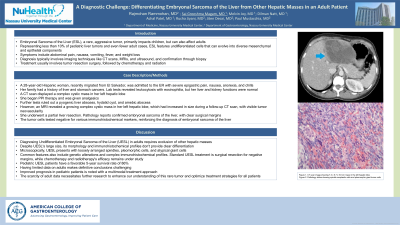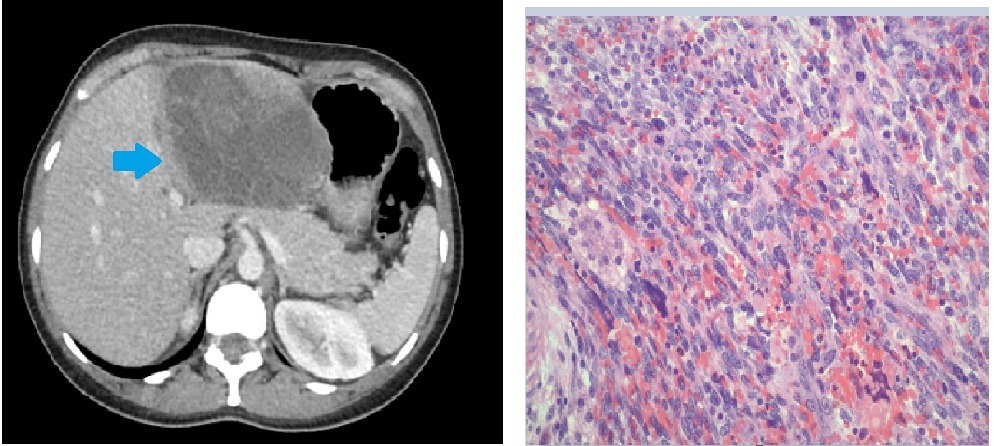Sunday Poster Session
Category: Liver
P1115 - A Diagnostic Challenge: Differentiating Embryonal Sarcoma of the Liver from Other Hepatic Masses in an Adult Patient
Sunday, October 22, 2023
3:30 PM - 7:00 PM PT
Location: Exhibit Hall

Has Audio

Sai Greeshma Magam, MD
Nassau University Medical Center
East Meadow, NY
Presenting Author(s)
Award: Presidential Poster Award
Rajmohan Rammohan, MD, Melvin Joy, MD, Sai Greeshma Magam, MD, Dilman Natt, MD, Tulika Saggar, MD, Achal Patel, MD, Ana Rivera, MD, Jiten Desai, MD, Paul Mustacchia, MD, MBA
Nassau University Medical Center, East Meadow, NY
Introduction: Embryonal Sarcoma of the Liver (ESL), a rare, aggressive tumor, primarily impacts children, but can also affect adults. Representing less than 10% of pediatric liver tumors and even fewer adult cases, ESL features undifferentiated cells that can evolve into diverse mesenchymal and epithelial components. Symptoms include abdominal pain, nausea, vomiting, fever, and weight loss. Diagnosis typically involves imaging techniques like CT scans, MRIs, and ultrasound, and confirmation through biopsy. Treatment usually involves tumor resection surgery, followed by chemotherapy and radiation
Case Description/Methods: A 28-year-old Hispanic woman, recently migrated from El Salvador, was admitted to the ER with severe epigastric pain, nausea, anorexia, and chills. Her family had a history of liver and stomach cancers. Lab tests revealed leukocytosis with eosinophilia, but her liver and kidney functions were normal. A CT scan displayed a complex cystic mass in her left hepatic lobe. She began PPI therapy and was given analgesics. Further tests ruled out a pyogenic liver abscess, hydatid cyst, and amebic abscess. However, an MRI revealed a growing complex cystic mass in her left hepatic lobe, which had increased in size during a follow-up CT scan, with visible tumor neovascularity. She underwent a partial liver resection. Pathology reports confirmed embryonal sarcoma of the liver, with clear surgical margins. The tumor cells tested negative for various immunohistochemical markers, reinforcing the diagnosis of embryonal sarcoma of the liver
Discussion: Diagnosing Undifferentiated Embryonal Sarcoma of the Liver (UESL) in adults requires exclusion of other hepatic masses. Despite UESL's large size, its morphology and immunohistochemical profiles don't provide clear differentiation. Microscopically, UESL presents with loosely arranged spindles, pleomorphic cells, and atypical giant cells. Common features also include genetic alterations and complex immunohistochemical profiles. Standard UESL treatment is surgical resection for negative margins, while chemotherapy and radiotherapy's efficacy remains under study. Pediatric UESL patients have a favorable 5-year survival rate of 86%. However, limited data on adults makes definitive conclusions challenging. Improved prognosis in pediatric patients is noted with a multimodal treatment approach. However, the scarcity of adult data necessitates further research to enhance our understanding of this rare tumor and optimize treatment strategies for all patients

Disclosures:
Rajmohan Rammohan, MD, Melvin Joy, MD, Sai Greeshma Magam, MD, Dilman Natt, MD, Tulika Saggar, MD, Achal Patel, MD, Ana Rivera, MD, Jiten Desai, MD, Paul Mustacchia, MD, MBA. P1115 - A Diagnostic Challenge: Differentiating Embryonal Sarcoma of the Liver from Other Hepatic Masses in an Adult Patient, ACG 2023 Annual Scientific Meeting Abstracts. Vancouver, BC, Canada: American College of Gastroenterology.
Rajmohan Rammohan, MD, Melvin Joy, MD, Sai Greeshma Magam, MD, Dilman Natt, MD, Tulika Saggar, MD, Achal Patel, MD, Ana Rivera, MD, Jiten Desai, MD, Paul Mustacchia, MD, MBA
Nassau University Medical Center, East Meadow, NY
Introduction: Embryonal Sarcoma of the Liver (ESL), a rare, aggressive tumor, primarily impacts children, but can also affect adults. Representing less than 10% of pediatric liver tumors and even fewer adult cases, ESL features undifferentiated cells that can evolve into diverse mesenchymal and epithelial components. Symptoms include abdominal pain, nausea, vomiting, fever, and weight loss. Diagnosis typically involves imaging techniques like CT scans, MRIs, and ultrasound, and confirmation through biopsy. Treatment usually involves tumor resection surgery, followed by chemotherapy and radiation
Case Description/Methods: A 28-year-old Hispanic woman, recently migrated from El Salvador, was admitted to the ER with severe epigastric pain, nausea, anorexia, and chills. Her family had a history of liver and stomach cancers. Lab tests revealed leukocytosis with eosinophilia, but her liver and kidney functions were normal. A CT scan displayed a complex cystic mass in her left hepatic lobe. She began PPI therapy and was given analgesics. Further tests ruled out a pyogenic liver abscess, hydatid cyst, and amebic abscess. However, an MRI revealed a growing complex cystic mass in her left hepatic lobe, which had increased in size during a follow-up CT scan, with visible tumor neovascularity. She underwent a partial liver resection. Pathology reports confirmed embryonal sarcoma of the liver, with clear surgical margins. The tumor cells tested negative for various immunohistochemical markers, reinforcing the diagnosis of embryonal sarcoma of the liver
Discussion: Diagnosing Undifferentiated Embryonal Sarcoma of the Liver (UESL) in adults requires exclusion of other hepatic masses. Despite UESL's large size, its morphology and immunohistochemical profiles don't provide clear differentiation. Microscopically, UESL presents with loosely arranged spindles, pleomorphic cells, and atypical giant cells. Common features also include genetic alterations and complex immunohistochemical profiles. Standard UESL treatment is surgical resection for negative margins, while chemotherapy and radiotherapy's efficacy remains under study. Pediatric UESL patients have a favorable 5-year survival rate of 86%. However, limited data on adults makes definitive conclusions challenging. Improved prognosis in pediatric patients is noted with a multimodal treatment approach. However, the scarcity of adult data necessitates further research to enhance our understanding of this rare tumor and optimize treatment strategies for all patients

Figure: Ct scan image showing 7.3 x 5.7 x 5.8 cm mass in the left hepatic lobe / Pathology slides showing spindle neoplastic cells and pleomorphic giant tumor cells
Disclosures:
Rajmohan Rammohan indicated no relevant financial relationships.
Melvin Joy indicated no relevant financial relationships.
Sai Greeshma Magam indicated no relevant financial relationships.
Dilman Natt indicated no relevant financial relationships.
Tulika Saggar indicated no relevant financial relationships.
Achal Patel indicated no relevant financial relationships.
Ana Rivera indicated no relevant financial relationships.
Jiten Desai indicated no relevant financial relationships.
Paul Mustacchia indicated no relevant financial relationships.
Rajmohan Rammohan, MD, Melvin Joy, MD, Sai Greeshma Magam, MD, Dilman Natt, MD, Tulika Saggar, MD, Achal Patel, MD, Ana Rivera, MD, Jiten Desai, MD, Paul Mustacchia, MD, MBA. P1115 - A Diagnostic Challenge: Differentiating Embryonal Sarcoma of the Liver from Other Hepatic Masses in an Adult Patient, ACG 2023 Annual Scientific Meeting Abstracts. Vancouver, BC, Canada: American College of Gastroenterology.

